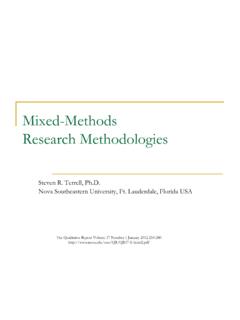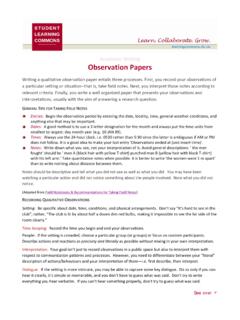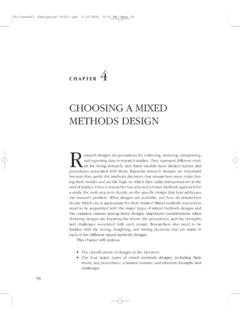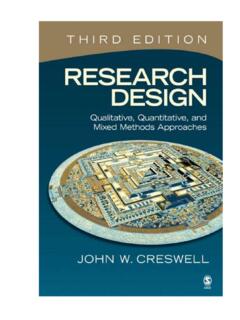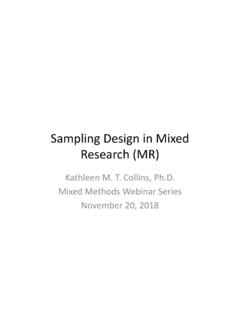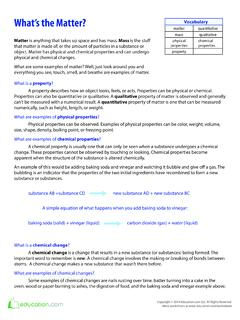Transcription of MIXED METHODS RESEARCH QUESTIONS AND …
1 138 MIXED METHODS RESEARCH QUESTIONS AND HYPOTHESESIn discussions about METHODS , researchers typically do not see specificquestions or hypotheses especially tailored to MIXED METHODS , discussion has begun concerning the use of MIXED methodsquestions in studies and also how to design them (see Creswell & PlanoClark, 2007; Tashakkori & Creswell, 2007). A strong MIXED methodsstudy should start with a MIXED METHODS RESEARCH question , to shape themethods and the overall design of a study.
2 Because a MIXED methodsstudy relies on neither quantitative or qualitative RESEARCH alone, somecombination of the two provides the best information for the researchquestions and hypotheses. To be considered are what types of questionsshould be presented and when and what information is most needed toconvey the nature of the study: Both qualitative and quantitative RESEARCH QUESTIONS (or hypotheses)need to be advanced in a MIXED METHODS study in order to narrow andfocus the purpose statement.
3 These QUESTIONS or hypotheses can beadvanced at the beginning or when they emerge during a later phase ofthe RESEARCH . For example, if the study begins with a quantitative phase,the investigator might introduce hypotheses. Later in the study, when thequalitative phase is addressed, the qualitative RESEARCH QUESTIONS appear. When writing these QUESTIONS or hypotheses, follow the guidelines inthis chapter for scripting good QUESTIONS or hypotheses. Some attention should be given to the order of the RESEARCH ques-tions and hypotheses.
4 In a two-phase project, the first-phase questionswould come first, followed by the second-phase QUESTIONS so that readerssee them in the order in which they will be addressed in the proposed a single-phase strategy of inquiry, the QUESTIONS might be orderedaccording to the method that is given the most weight in the design. Include a MIXED METHODS RESEARCH questionthat directlyaddresses the mixing of the quantitative and qualitative strands of theresearch. This is the question that will be answered in the study based onthe mixing (see Creswell & Plano Clark, 2007).
5 This is a new form of ques-tion in RESEARCH METHODS , and Tashakkori and Creswell (2007, p. 208)call it a hybrid or integrated question . This question could either bewritten at the beginning or when it emerges; for instance, in a two-phasestudy in which one phase builds on the other, the MIXED METHODS ques-tions might be placed in a discussion between the two phases. This canassume one of two forms. The first is to write it in a way that conveysthe METHODS orproceduresin a study ( , Does the qualitative data helpexplain the results from the initial quantitative phase of the study?)
6 SeeDesigning Research07-Creswell (RD)-45593:07-Creswell (RD) 6/20/2008 4:37 PM Page 138 RESEARCH QUESTIONS and HypothesesCreswell & Plano Clark, 2007). The second form is to write it in a waythat conveys the contentof the study ( , Does the theme of social sup-port help to explain why some students become bullies in schools? (seeTashakkori & Creswell, 2007.) Consider several different ways that all types of RESEARCH QUESTIONS ( , quantitative , qualitative , and MIXED ) can be written into a mixedmethods study: Write separate quantitative QUESTIONS or hypotheses and qualita-tive QUESTIONS .
7 These could be written at the beginning of a studyor when they appear in the project if the study unfolds in stages orphases. With this approach, the emphasis is placed on the twoapproaches and not on the MIXED METHODS or integrative compo-nent of the study. Write separate quantitative QUESTIONS or hypotheses and qualita-tive QUESTIONS and follow them with a MIXED METHODS highlights the importance of both the qualitative and quan-titative phases of the study as well as their combined strength, andthus is probably the ideal approach.
8 Write only a MIXED METHODS question that reflects the proceduresorthe content(or write the MIXED METHODS question in both a proce-dural and a content approach), and do not include separate quan-titative and qualitative QUESTIONS . This approach would enhancethe viewpoint that the study intends to lead to some integration orconnection between the quantitative and qualitative phases of thestudy ( , the sum of both parts is greater than each part).139 Example and RESEARCH QUESTIONS in aMixed METHODS StudyHoutz (1995) provides an example of a two-phase study with the separatequantitative and qualitative RESEARCH hypotheses and QUESTIONS stated insections introducing each phase.
9 She did not use a separate, distinct mixedmethods RESEARCH question . Her study investigated the differences betweenmiddle-school (nontraditional) and junior high (traditional) instructionalstrategies for seventh-grade and eighth-grade students and their attitudestoward science and their science achievement. Her study was conducted at apoint when many schools were moving away from the two-year junior highconcept to the three-year middle school (including sixth grade) approach toeducation.
10 In this two-phase study, the first phase involved assessing pre-test (Continued)07-Creswell (RD)-45593:07-Creswell (RD) 6/20/2008 4:37 PM Page 139140 Designing RESEARCH (Continued)and post-test attitudes and achievement using scales and examination then followed the quantitative results with qualitative interviews withscience teachers, the school principal, and consultants. This second phasehelped to explain differences and similarities in the two instructionalapproaches obtained in the first a first-phase quantitative study, Houtz (1995, p.)










